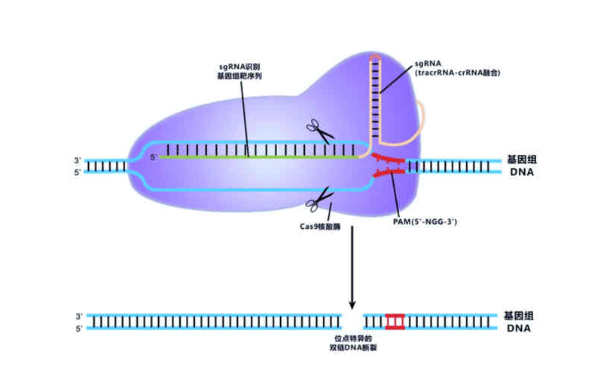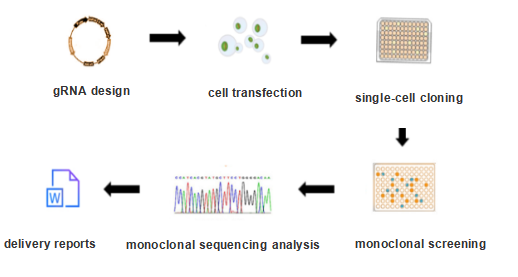2023-07-14 Hits(383)
CRISPR/Cas9 (Clustered Regularly Interspaced Short Palindromic Repeats) is an emerging technique in which sgRNA directs Cas endonuclease to perform specific DNA modifications to targeted genes. The CRISPR/Cas9 system is widely found in prokaryotic genes and is an adaptive immune defense mechanism evolved by bacteria and archaea in response to the constant attack of viruses and plasmids.
CRISPR/Cas systems are divided into two categories, the most typical and widely used CRISPR system is the type II CRISPR/Cas9 system. In type II CRISPR systems, CRISPR RNA (crRNA) is annealed with transcriptional activation crRNA (tracrRNA) through base pairing to form complexes that specifically recognize genome sequences zygotes, which then bind and invade DNA through PAM (5'-NGG-3') sequences, guiding Cas9 endonuclease to cleave DNA double-strand breaks (DSBs) in the fragment of interest.

Figure 1: Schematic Diagram of CRISPR/Cas9
(1) It has the advantages of high editing efficiency, simple construction and convenient operation
(2) Effective and flexible gene knockout can be achieved at a low cost
(3) It has a broad spectrum and has no gene, cell and species restrictions
(4) Multiple target sites can be used for gene targeting at the same time
(5) Rich in functions, it can realize knockout, insertion, inhibition, activation and other target genes
CRISPR/Cas9 knockout cell lines are widely used in many fields, especially in the treatment of genetic diseases, screening and detection of disease-related genes, tumor treatment, the transformation of animals and plants, and prevention of pathogenic microorganisms, which can effectively improve the quality of human life.
Although previous explanations have suggested that CRISPR/Cas9 is a promising approach, this editing system still has many limitations and risks, making its use in clinical trials challenging due to its recent discovery and use in humans. Immunogenicity, off-targeting, polymorphisms, delivery techniques and ethical issues are major limitations and difficulties.
KMD Bioscience can provide CRISPR/Cas9 knockout cell lines with the following main processes: gRNA design, cell transfection, single-cell cloning, monoclonal screening, monoclonal sequencing analysis, and delivery reports.

Figure 2:Flow diagram of CRISPR/Cas9
6.1.1 Digestion of the vector plasmid pAC1371 with BbsI at 37°C.
6.1.2 Refer to the instructions for the DNA fragment recovery kit to recover the target vector.
6.1.3 Primer annealing.
Annealing in a PCR ring instrument using the following parameters:
|
Reagent |
Dosage |
|
Oligo 1(100μM) |
1.0 |
|
Oligo 2(100μM) |
1.0 |
|
ddH2O |
7.5 |
|
T4 PNK(NEB) |
0.5 |
|
Total |
10 |
37°C for 30 min, 95°C for 5 min, then reduce the temperature to 25°C at a rate of 5°C per minute.
6.1.4 Ligase ligation.
6.1.5 Plasmid Transformation.
(1) Take DH5a competent cells and thaw them on ice, add 5-10μl of ligation products to the receptive cells after thawing, stir gently with the tip (do not shake violently), and incubate in the refrigerator for 25-30 minutes.
(2) After incubating the competent cells on ice, adjust the temperature to 42°C in a water bath in advance and heat for 90 seconds.
(3) Add 500 μl of liquid medium pre-warmed to room temperature and place in a 37°C shaker to resuscitate the shaker for 1h.
(4) Centrifuge at 3000 rpm for 3 min, discard part of the supernatant, plate with a glass rod cooled to room temperature by sterilization, and grow overnight in a 37°C incubator.
(5) Randomly pick independently grown plaque and culture it in the liquid medium for 6-8 hours for colony PCR.
(6) Perform agarose gel electrophoresis with PCR products. The gel imager was imaged, and the positive colonies were selected and sent to the sequencing company for sequencing identification.
(7) According to the sequencing results, select the target colony to expand the culture, extract the plasmid, and prepare it for subsequent laboratory use.
6.2.1 Preparation: Cells are prepared to passage well-growing HEK293T cells in a certain number.
6.2.2 Replace HEK293T cells with well-grown, appropriately dense HEK293T cells with half fresh medium.
6.2.3 pMD2.G: 1μg+paspax2: 1μg +transgene: 2μg+optimem: 0.126ml mix well and let stand for 5 minutes at room temperature, lipofectamine 2000: 8μl+optimem: 0.125ml mix well and let stand at room temperature for 5 minutes.
6.2.4 After 5 minutes, gently mix the two mixtures from step 5.2.3 and let stand at room temperature for 15 minutes.
100 cells are laid out in a large dish or 96 well plate. The remaining cells are cryopreservation. When colony-like clumps are visible to the naked eye, digest them from large plates or 96 well plate and transfer them to 12 or 24 well plate to continue expanding the culture. Be careful not to contaminate other cell masses and do not select overly dense cell clumps.
The use of specific screening markers, such as fluorescent proteins or antibiotic resistance genes, can also help screen clones that successfully knock out the gene of interest.
Polymerase chain reaction (PCR) is used to amplify the DNA sequence of the gene of interest and gel electrophoresis or sequencing techniques are used to detect mutations or deletions.
Deliver a complete report of the experimental process documentation.
With the continuous development of CRISPR/Cas9 technology, which has been widely used in various species, KMD Bioscience can provide high efficiency, system stability, low off-target and transparent CRISPR/Cas9 knockout cell line construction services, as well as gene knockout, overexpression, silencing, fixed-site integration and other types of gene editing services.